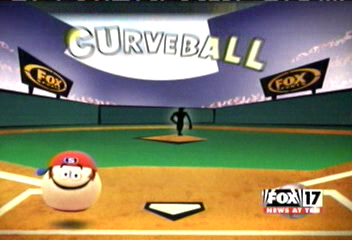With the talk of ESPN’s SkyCam and the response from sports fans around the country, it got me thinking about the best and worst innovations with regards to sports on television. It may not seem like it when you watch a game today, but things have changed drastically over the years in how we watch our sports. Some ideas have changed certain sports for the better, and even created a fanbase for some. Others have been so laughable that they have long been forgotten. Of course, with only five good and bad listed, this is nowhere near a complete list and doesn’t go back as far to include things like color TV or instant replay. Leave us a thought below on what we left out. Enjoy!
5 Worst Sports Innovations
5) Sideline Reporters
-Believe it or not, sideline reporters date back to the mid-70s. In fact, it’s believed that the first sideline reporter was none other than HBO Boxing play by play man Jim Lampley. Deadspin has a nice feature on Lampley and his first job in the business… and his disdain for the stupidity of the job. Since Lampley, sideline reporters have naturally evolved into a pointless existence. CBS has gotten rid of them on their NFL broadcasts without missing a beat. There are some today that do a good job with what they have like Lisa Salters, Rob Stone, or Erin Andrews, but the nature of the beast is the problem. The wide majority of sideline reports are completely unnecessary and add little to a broadcast. When news does come from a sideline report, it’s usually for negative reasons – do the words I want to kiss you ring a bell? Maybe sideline reporters aren’t so bad though, it has given us comedic gold like John L Smith and this video below from Michigan hockey. If only all sideline reports were like this, they may be worthwhile. Take it away, GUYS!
4) Scooter
-It’s sad that there could be so much hatred for a lovable looking cartoony baseball… but yet, MLB on Fox coverage is known for taking us to levels of hell previously uninhabited by mortal men. Scooter is perhaps the clearest example of this phenomenon. Scooter was meant to… well, actually, I have no idea what his (or her?) purpose was, except to explain things that baseball fans over the age of three already knew. This demon spawn looks innocent enough, but children cried whenever he came on the screen during Fox’s MLB games. It made adults yearn for Joe Buck and Tim McCarver to come back and save us. Thankfully, Scooter only lasted a couple years in the middle part of the 2000s, but it was long enough to leave a lasting impact that still haunts many baseball fans to this day.
3) Dennis Miller
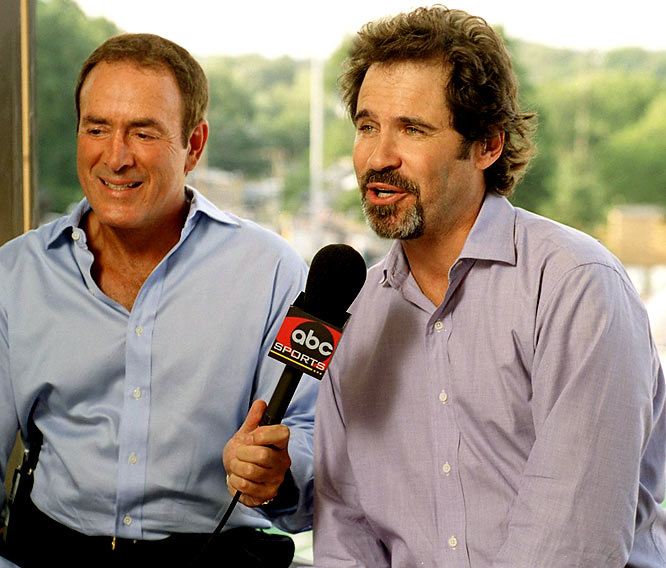
-Take yourself back to 11 years ago. Monday Night Football ratings were going down the toilet and ABC drastically needed a change to excite young fans again. Seems impossible now, but the NFL’s premier TV franchise was struggling. The answer that ABC sports provided was to experiment with Monday Night Football by adding comedian Dennis Miller to the broadcast booth… cha cha. The idea seems as crazy and misguided now as it did then. Miller was awkward at best in the booth, caught in-between trying to be an NFL analyst and, well, a comedian. Somehow, Miller’s jokes about Greek philosophy, the debt ceiling, and Prussian monarchs didn’t mesh with the NFL audience. The Miller experiment lasted two woeful seasons. When ESPN picked up the franchise in 2006, they tried to go the unconventional route again with PTI co-host Tony Kornheiser in a slightly less disastrous move. Kornheiser lasted one more year than Miller.
2) SkyCam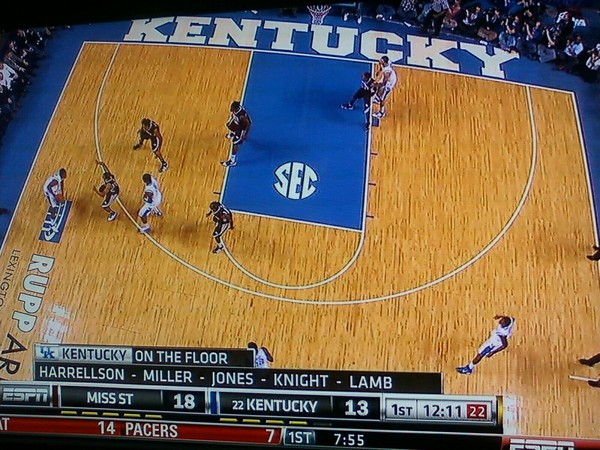
-We’ve chronicled the most recent and dizzying sports broadcasting blunder the last couple weeks from the initial Twitter reaction to the predictable comeback from ESPN. Perhaps ESPN should have realized that their use of SkyCam for the bulk of Kentucky-Mississippi State two weeks ago would bring the scorn of college basketball fans anywhere. I can’t think of anyone who has ever thought to themselves, “wouldn’t it be awesome to watch a game hovering beneath the scoreboard and constantly twirling around back and forth.” Apparently, someone important at ESPN thought just that, although I’ve never seen seats sold in mid-air above center court. ESPN should take solace though that it’s only the second entry on our list to induce vertigo amongst viewers, that and Dennis Miller’s commentary.
1) Glow Puck
-Even though SkyCam was a terrible idea, it doesn’t come in at #1. For our worst idea, we go to Fox once again and the infamous Glow Puck. The idea behind the glow puck wasn’t a bad one – not everyone can see the hockey puck at all times, so let’s light it up so folks can see it all the time. However, when the glow puck made its debut in 1996, we quickly realized how terrible it was in reality. Really, I was 10 at the time and I knew it was awful… and yes, I was a hardcore hockey fan at the time. NHL ’96 was my life. Between the blue haze and the red streaks, it was just plain distracting to the actual hockey broadcast. The glow puck was in action just a couple years, almost as quickly as Fox was in and out of the NHL. Observe and relive all of its glowy infamy below!
5 Best Sports Innovations
5) Hawk Eye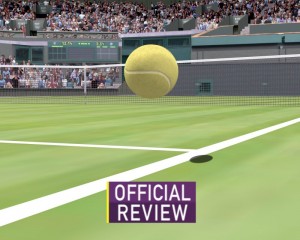
-Hawk Eye and the replay system has changed not only the way tennis has been presented on TV, but the sport itself. But, did you know that the Hawk Eye technology was actually first used for cricket coverage in the UK? Specifically, Hawk Eye was used for tracking balls and showing the accuracy of leg before wicket decisions. When the technology was transferred to tennis, viewers were able to see where balls landed and whether they were in or out. The system was so successful, Hawk Eye was implemented to provide players with challenge opportunities on line calls.
4) NFL Sunday Ticket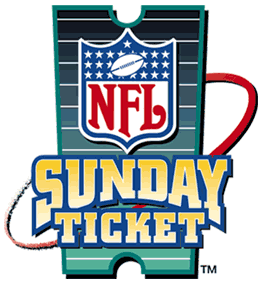
-I grew up in the middle of Ohio as a Saints fan, don’t ask me why, I don’t even know. Now, as a Saints fan in the 90s, you can imagine that access to my favorite team was few and far between. Sunday afternoons were spent watching the Browns or Bengals and just waiting for the score ticker to come across the TV to update me on my team. I’m sure millions of fans across the country felt the same way. Then, in 1994, DirecTV and the NFL liberated fans by giving access to every NFL game through Sunday Ticket. While not technically an in-game innovation, Sunday Ticket changed the way sports are watched by giving fans access to the games and teams that they want to watch, not what local stations dictated. DirecTV has built on the success of Sunday Ticket with the popular RedZone channel as well. I’m convinced Sunday Ticket is one of the central reasons behind the NFL’s insane rise in popularity the last 15 years, it’s certainly made me a very happy Saints fan.
3) Hole Card Cameras
-Perhaps no innovation has done more to help a sport (that is, if you consider vampire-like creatures that sit at tables for numerous hours every day sport) than the hole card camera for poker. With the advent of the holecam, viewers were taken inside the action for the first time and poker was made into a television sport. We could all see which players were bluffing, which players had the nuts, and why the best players were so good. In a way, the curtain was raised on top level poker. The World Poker Tour and World Series of Poker on ESPN experienced unprecedented gains in popularity – the WSOP itself increased from 512 entrants in 2000 to a record 8,773 in 2006. The poker boom has subsided, but it still remains as a popular TV sport largely because of those tiny cameras.
2) The Yellow 1st & 10 Line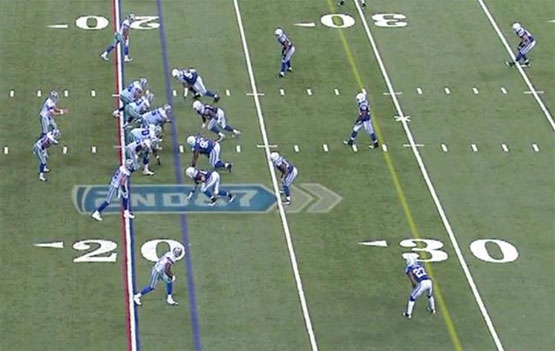
-Another great innovation that changed the way we enjoy sports is the famous yellow line. It’s hard now to even ponder a football broadcast without it! Although the yellow line may be minor in the grand scheme of things, it is a genius idea. Getting first downs is what makes football what it is, so why not let every viewer know when teams reach the line to gain. The idea has been supplemented with a blue line to signify the line of scrimmage (also handy for noticing how many yards a certain play gains) and on-screen down and distance graphics, which may be a little too much. You can check out this Discovery Channel article on how the yellow line works. The universal appeal of the yellow line should show broadcast execs that subtle yet meaningful innovations are the way to go.
1) The Fox Box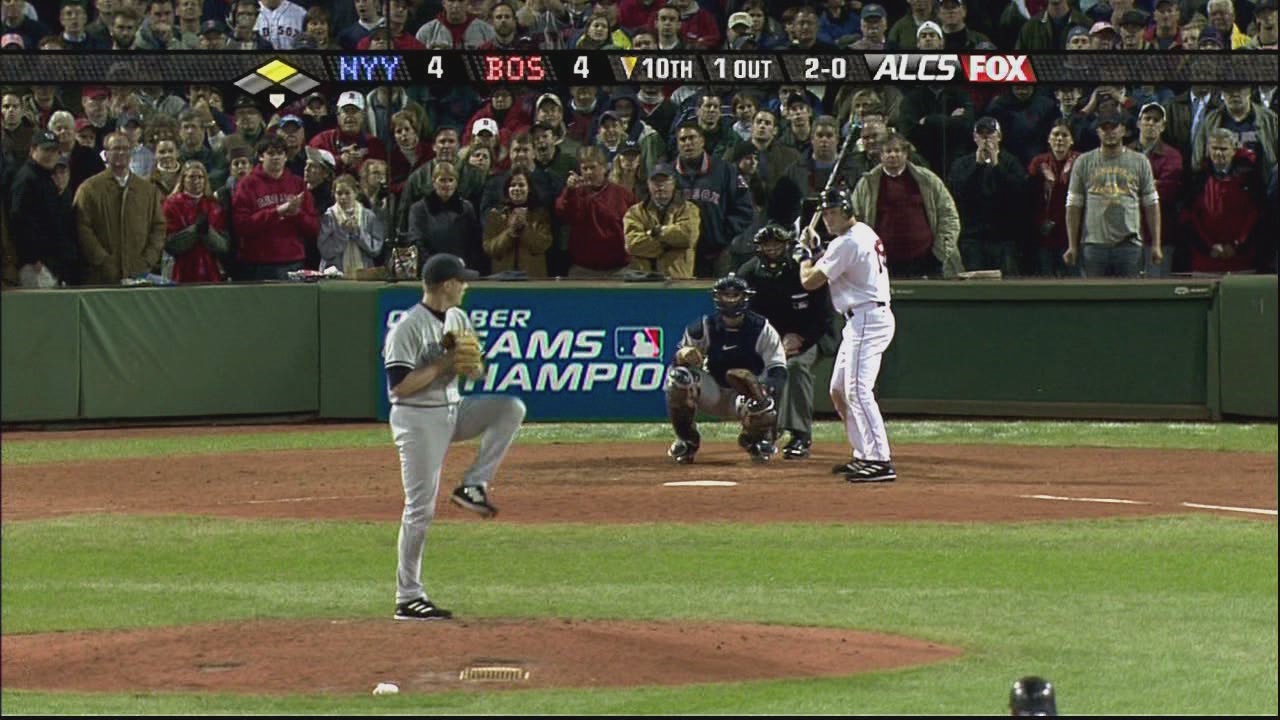
-As the network that has undoubtedly had the most experiments throughout the years, Fox claims the best and worst broadcast innovation in our lists. Fox has had some bad ideas (see #4 and #1 above), but they hit a home run with the implementation of the Fox Box for its NFL coverage in 1994. In years prior, a score graphic would appear periodically throughout a broadcast. In football, a down and distance may flash or in baseball a pitch count may appear, but never permanently on the screen. Could you even imagine turning on a game now and not instantly knowing the game situation? The Fox Box changed sports TV for the better, and now every network that telecasts sports shows a score and game situation graphic on the screen. Whether these graphics are a banner at the top or bottom of the screen, or in a corner of your screen, we are always aware of what’s happening in a game at a given moment. It’s the best thing to happen to watching sports on television.
***Update: Thanks for all the comments and responses. One interesting response we received in the AA inbox was from ESPN Senior Director of Communications Bill Hofheimer. Bill wrote to point out ESPN’s involvement in the 1st & 10 line (mentioned in the Discovery link), and stake Bristol’s claim as the most innovative network. Some of the notable ideas ESPN have produced for game broadcasts are SkyCam (the non-basketball version), K-Zone, and ESPN Axis (especially great in soccer). Others on the list we received from Bill include the PTI rundown and the 28/58 score updates. It’s nice to hear a response from ESPN on the lists (maybe other networks would like to chime in too?) and hopefully AA nation will appreciate Bill’s input as well. Keep the responses and comments coming on other ideas or innovations and perhaps we’ll expand on these lists in the future!***

